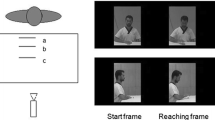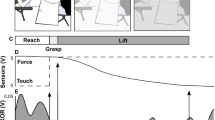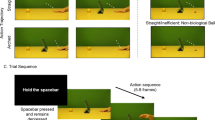Abstract
Body movement provides a rich source of information about other people’s goals and intentions. In the present study, we examined a particular aspect concerned with the interpretation of bodily movement—how well people can distinguish between different social intentions by observing a reach-to-grasp movement. To ascertain to what extent intention-from-motion judgements rely on visual kinematics, we compared prediction performance on a typical temporal-occlusion video task with prediction performance on a temporal-occlusion point-light task. In the video task, participants observed videos showing a model reaching towards and grasping a wooden block with different intents: to cooperate with a partner in building a tower, compete with an opponent to be the first to put the object in the middle of the working surface, or perform an individual action. In the point-light task, participants observed point-light displays of the same movements. Although predictions were more accurate for the video task, prediction performance was not disrupted for the point-light task, suggesting that essential kinematic information available in point-light displays was indeed sufficient for intention-from-motion judgement. Importantly, the same kinematic landmarks were used to discriminate between social intentions for the video and the point-light task. This suggests that observers not only have the ability to use kinematic information when no other information is available, but they use kinematic information to discriminate between intentions when watching the motion of others under full light conditions.


Similar content being viewed by others
References
Abernethy B, Zawi K (2007) Pickup of essential kinematics underpins expert perception of movement patterns. J Mot Behav 39:353–367
Abernethy B, Gill DP, Parks SL, Packer ST (2001) Expertise and the perception of kinematic and situational probability information. Perception 30:233–252
Abernethy B, Zawi K, Jackson RC (2008) Expertise and attunement to kinematic constraints. Perception 37:931–948
Aglioti SM, Cesari P, Romani M, Urgesi C (2008) Action anticipation and motor resonance in elite basketball players. Nat Neurosci 11:1109–1116
Ansuini C, Santello M, Massaccesi S, Castiello U (2006) Effects of end-goal on hand shaping. J Neurophysiol 95:2456–2465
Ansuini C, Giosa L, Turella L, Altoe G, Castiello U (2008) An object for an action, the same object for other actions: effects on hand shaping. Exp Brain Res 185:111–119
Atkinson AP, Dittrich WH, Gemmell AJ, Young AW (2004) Emotion perception from dynamic and static body expressions in point-light and full-light displays. Perception 33:717–746
Becchio C, Sartori L, Bulgheroni M, Castiello U (2008a) The case of Dr. Jekyll and Mr. Hyde: a kinematic study on social intention. Conscious Cogn 17:557–564
Becchio C, Sartori L, Bulgheroni M, Castiello U (2008b) Both your intention and mine are reflected in the kinematics of my reach-to-grasp movement. Cognition 106:894–912
Becchio C, Sartori L, Castiello U (2010) Towards you: the social side of actions. Curr Dir Psychol Sci 19:183–188
Blakemore S-J, Frith CD (2005) The role of motor contagion in the prediction of action. Neuropsychologia 43:260–267
Calvo-Merino B, Glaser DE, Grèzes J, Passingham RE, Haggard P (2005) Action observation and acquired motor skills: an fMRI study with expert dancers. Cereb Cortex 15:1243–1249
Chaminade T, Hodgins J, Kawato M (2007) Anthropomorphism influences perception of computer-animated characters’ actions. Soc Cogn Affect Neurosci 2:206–216
Clarke TJ, Bradshaw MF, Field DT, Hampson SE, Rose D (2005) The perception of emotion from body movement in point-light displays of interpersonal dialogue. Perception 34:1171–1180
Dittrich WH (1993) Action categories and the perception of biological motion. Perception 22:15–22
Dittrich WH, Troscianko T, Lea SE, Morgan D (1996) Perception of emotion from dynamic point-light displays represented in dance. Perception 25:727–738
Frith CD, Frith U (2006) The neural basis of mentalizing. Neuron 50:531–534
Georgiou I, Becchio C, Glover S, Castiello U (2007) Different action patterns for cooperative and competitive behaviour. Cognition 102:415–433
Grezes J, Frith C, Passingham RE (2004) Brain mechanisms for inferring deceit in the actions of others. J Neurosci 24:5500–5505
Heeger D (1997) Signal detection theory. Published online: http://www.cns.nyu.edu/~david/handouts/sdt-advanced.pdf
Kilner JM, Vargas C, Duval S, Blakemore S-J, Sirigu A (2004) Motor activation prior to observation of a predicted movement. Nat Neurosci 7:1299–1301
Knoblich G, Flach R (2001) Predicting the effects of actions: interactions of perception and action. Psychol Sci 12:467–472
Macmillan NA, Creelman CD (2005) Detection theory: a user’s guide, 2nd edn. Lawrence Erlbaum Associates, Mahwah
Macmillan NA, Kaplan HL (1985) Detection theory analysis of group data: estimating sensitivity from average hit and false-alarm rates. Psychol Bull 98:185–199
Pollick FE, Paterson HM, Bruderlin A, Sanford AJ (2001) Perceiving affect from arm movement. Cognition 82:B51–B61
Pollick FE, Lestou V, Ryu J, Cho SB (2002) Estimating the efficiency of recognizing gender and affect from biological motion. Vision Res 42:2345–2355
Prinz W (1997) Perception and action planning. Eur J Cogn Psychol 9:129–154
Prinz W (2006) What re-enactment earns us. Cortex 42:515–517
Rizzolatti G, Sinigaglia C (2010) The functional role of the parieto-frontal mirror circuit: interpretations and misinterpretations. Nat Rev Neurosci 11:264–274
Runeson S, Frykholm G (1983) Kinematic specification of dynamics as an informational basis for person-and-action perception: expectation, gender recognition, and deceptive intention. J Exp Psychol Gen 112:585–615
Sartori L, Becchio C, Castiello U (2011) Cues to intention: the role of movement information. Cognition 119:242–252
Sartori L, Becchio C, Bara BG, Castiello U (2009) Does the intention to communicate affect action kinematics? Conscious Cogn 18:766–772
Schütz-Bosbach S, Prinz W (2007) Perceptual resonance. Action-induced modulation of perception. Trends in Cogn Sci 11:349–355
Sebanz N, Shiffrar M (2009) Detecting deception in a bluffing body: the role of expertise. Psychon Bull Rev 16:170–175
Shim J, Carlton LG, Chow JW, Chae W (2005) The use of anticipatory visual cues by highly skilled tennis players. J Mot Behav 37:164–175
Umiltà MA, Kohler E, Gallese V, Fogassi L, Fadiga L, Keysers C, Rizzolatti G (2001) I know what you are doing. A neurophysiological study. Neuron 31:155–165
Vanrie J, Verfaillie K (2004) Perception of biological motion: a stimulus set of human point-light actions. Behav Res Methods Instrum Comput 36:625–629
Vingerhoets G, Honore P, Vandekerckhove E, Nys J, Vandemaele P, Achten E (2010) Multifocal intraparietal activation during discrimination of action intention in observed tool grasping. Neuroscience 169:1158–1167
Wilson M, Knoblich G (2005) The case for motor involvement in perceiving conspecifics. Psychol Bull 131:460–473
Wöllner C, Cañal-Bruland R (2010) Keeping an eye on the violinist: motor experts show superior timing consistency in a visual perception task. Psychol Res 74:579–585
Wolpert DM, Flanagan JR (2001) Motor prediction. Curr Biol 11:R729–R732
Author information
Authors and Affiliations
Corresponding author
Rights and permissions
About this article
Cite this article
Manera, V., Becchio, C., Cavallo, A. et al. Cooperation or competition? Discriminating between social intentions by observing prehensile movements. Exp Brain Res 211, 547–556 (2011). https://doi.org/10.1007/s00221-011-2649-4
Received:
Accepted:
Published:
Issue Date:
DOI: https://doi.org/10.1007/s00221-011-2649-4




